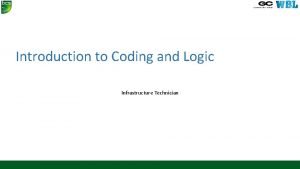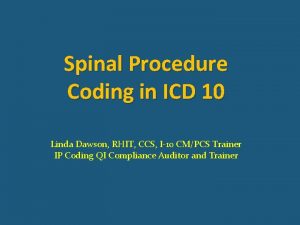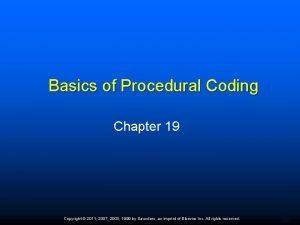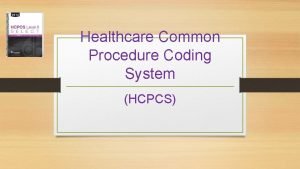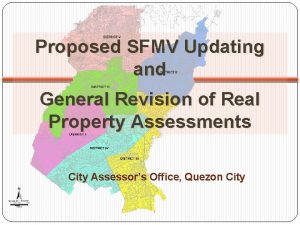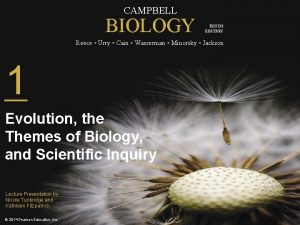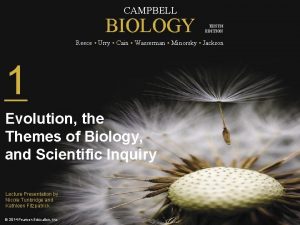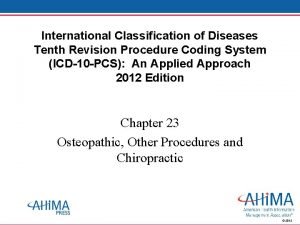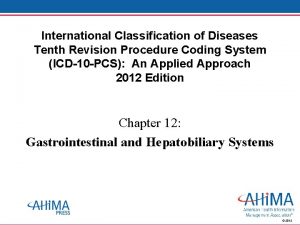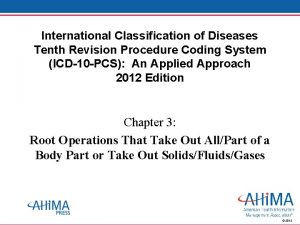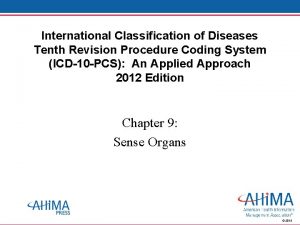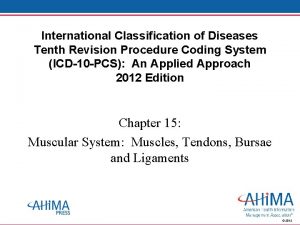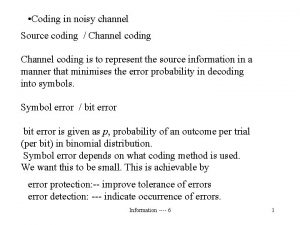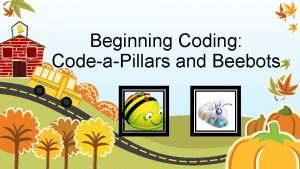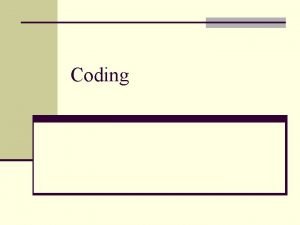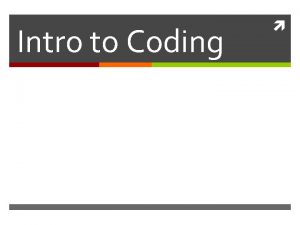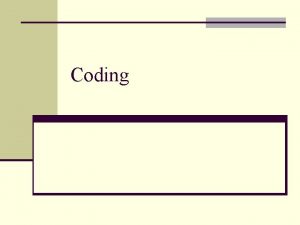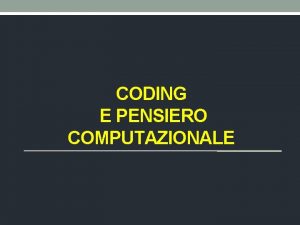International Classification of Diseases Tenth Revision Procedure Coding

















- Slides: 17

International Classification of Diseases Tenth Revision Procedure Coding System (ICD-10 -PCS): An Applied Approach 2012 Edition Chapter 4: Root Operations That Cut or Separate, Put in or Put Back, or Move Body Parts © 2013

Root Operations Involving Cutting or Separation Only • Division • Release © 2012

Division (8) • Cutting into a body part without drawing fluids and/or gases from the body part in order to separate or transect a body part • Key is to separate into two or more portions • E. g. Osteotomy, spinal cordotomy © 2012

Release (N) • Freeing a body part from an abnormal physical constraint by cutting or the use of force • Freeing is the key word • Some restraining tissue may be taken out, but none of the body part © 2012

Coding Guideline for Release • B 3. 13 – In the root operation Release, the body part value coded is the body part being freed and not the tissue being manipulated or cut to free the body part -Example – lysis of intestinal adhesions is coded to the specific intestine body part value © 2012

Division and Release • Coding Guideline B 3. 14 - If the sole objective of the procedure is freeing the body part without cutting the body part, the root operation is Release. If the sole objective of the procedure is separating or transecting a body part, the root operation is Division © 2012

Division vs. Release Freeing a nerve root from surrounding scar tissue to relive pain = Release • Severing a nerve root to relieve pain = Division • © 2012

Root Operations that Put in/Put Back or Move Some or All of a Body Part • • Transplantation Reattachment Transfer Reposition © 2012

Transplantation (Y) • Putting in or on all or a portion of a living body part taken from another individual or animal to physically take the place and/or function of a all or a portion of a similar body part • Limited number of codes for Transplantation available for those organs that are currently transplanted E. g. , heart, lungs, kidney -Not cornea transplant – coded as Replacement • Codes can be added as new transplants are performed © 2012

Transplant Qualifiers • Allogeneic- taken from different individuals of the same species • Syngeneic-having to do with individuals or tissues that have identical genes • Zooplastic-tissue from an animal to a human © 2012

Transplantation Guideline • B 3. 16 – Putting in a mature and functioning living body part taken from another individual or animal is coded to the root operation transplantation. Putting in autologous or nonautologous cells is coded to the Administration section. -Example –Putting in autologous or nonautologous bone marrow, pancreatic islet cells, or stem cells is coded to the Administration section © 2012

Reattachment (M) • Putting back in or on all or a portion of a separated body part to its normal location or other suitable location • Body part that was cut off or avulsed is reattached with or without the blood and serve supply being restored • E. g. avulsed kidney, finger, hand or arm © 2012

Transfer (X) • Moving, without taking out, all or a portion of a body part to another location to take over the function of all or a portion of a body part • Blood vessels and nerves stay attached • E. g. Pedicle transfer, advancement flaps • Not free grafts = Replacement © 2012

Multi-layer Transfer Procedures • For Transfer procedures involving more than one layer -Character 4 for body part is for the deepest tissue layer -Character 7 for the qualifier indicates other layer(s) involved in the Transfer © 2012

Reposition (S) • Moving to its normal location or other suitable location all or a portion of a body part • Objective is to restore or establish normal function • Body part or portion of the body part may or may not be removed to be relocated © 2012

Reposition for Fractures • Provider will likely use the term Reduction -Coder to translate this term to match the ICD-10 -PCS term • Only displaced fractures coded to Reposition • Nondisplaced fractures involve a crack in the bone without any misalignment © 2012

Coding Guideline B 3. 15 • Reduction of a displaced fracture is coded to the root operation Reposition, and the application of a cast or splint in conjunction with the Reposition procedure is not coded separately. Treatment of a nondisplaced fracture is coded to the procedure performed o Example – putting a pin in a nondisplaced fracture is coded to the root operation Insertion. Casting of a nondisplaced fracture is coded to the root operation Immobilization in the Placement section © 2012
 Axial coding adalah
Axial coding adalah Contoh axial coding
Contoh axial coding Active and passive vocabulary
Active and passive vocabulary Bcs infrastructure technician
Bcs infrastructure technician History of qualitative research
History of qualitative research Coding dna and non coding dna
Coding dna and non coding dna Thecal sac
Thecal sac Chapter 19 procedural coding
Chapter 19 procedural coding Healthcare common procedure coding system
Healthcare common procedure coding system Classification of periradicular diseases
Classification of periradicular diseases General revision of assessments and property classification
General revision of assessments and property classification The tenth man graham greene summary
The tenth man graham greene summary Round 683 492 to the nearest hundred thousand
Round 683 492 to the nearest hundred thousand Campbell biology tenth edition
Campbell biology tenth edition Campbell biology tenth edition
Campbell biology tenth edition Campbell biology tenth edition
Campbell biology tenth edition Round 75 to nearest 10
Round 75 to nearest 10 55 round off
55 round off



